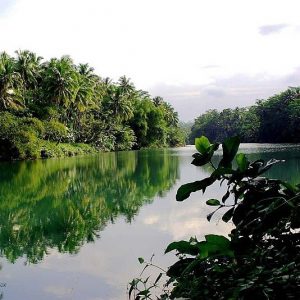Indonesia’s New Emission-Reduction Strategy To Emphasize Clean Energy, De-Emphasize Forests
Indonesia has long built its greenhouse-gas emission-reduction strategy on stifling its rampant deforestation, but the new climate action plan focuses on green energy. Climate-resistant agriculture remains a pillar of adaptation, and there is language calling for private-sector support of forest conservation, with more autonomy for individual states.

14 September 2015 | JAKARTA | Indonesia plans to limit its greenhouse-gas emissions to a level 29 percent below a business-as-usual projection by 2030, according to a draft copy of its climate action plan, or “Intended Nationally-Determined Contribution” (INDC), which Minister of Environment and Forestry Siti Nurbaya posted for comment on the ministry’s web site. That’s 3 percent deeper but ten years later than the current target, which was announced in 2009 and promises a 26 percent reduction by 2020 if the country goes it alone, and a 41 percent reduction if international help materializes.
Surprisingly, the new INDC relies heavily on curtailing rising emissions from the growing energy sector, and less on reducing emissions from deforestation and degradation of forests (REDD), which was a cornerstone of the country’s strategy before its REDD+ Agency was absorbed into the Ministry of Environment and Forestry in January. The current language emphasizes climate-resilient agriculture as part of the country’s efforts to adapt to climate change, and it also reiterates the need to involve the private sector in forest conservation, implying a move towards domestic REDD-type programs and away from international REDD payments.
“REDD+ has also been a priority initiative, implemented through Demonstration Areas (DAs) and voluntary initiatives throughout forested regions of the archipelago,” the English version of the document says. “Indonesia will protect its remaining forests by reducing deforestation and forest degradation, supporting ecosystem restoration and social forestry through the active participation of the private sector, small and medium enterprises, and local communities – in both the planning and implementation stages.”
It vows to continue the move towards “social forestry” that involves traditional communities and women, and to give individual states more leeway in developing their own strategies.
“A landscape-scale and ecosystem managemenl approach, emphasizing the role of subnational jurisdictions, is seen as critical to ensuring greater, more enduring benefits from
these initiatives,” it says.
“This public dissemination is our next phase before we’re submitting it to the UNFCCC (United Nations Framework Convention on Climate Change),” said Sarwono Kusumatmaja, Chair of the Climate Change Steering Committee, an ad-hoc body set up by the ministry to prepare for year-end climate talks in Paris. “We want the public to give their comments to make the best out of it.”
The public commenting period ends this week, and the official INDC is expected to be uploaded to the UNFCCC web site on September 20. Rachmat Witoelar, Indonesia’s prominent Special Envoy for Climate Change, described the 15-page document as “fair, ambitious, and unique.”
“It is fair to us because it’s based on our own condition,” he said. “It’s ambitious enough because we have calculated it from our own ability and it is unique because Indonesia’s INDC is the only document that pushes forward adaptation in the document.”
The Shift from Land-Use to Energy
Although Indonesia, like Brazil, is generally seen as an agricultural emitter, the current draft focuses more on the energy sector, followed by industry, agriculture, land use, land use change & forestry, and waste, although the government is still in negotiation over the exact percentages.
The shift is based on projections showing the country’s energy consumption, especially electricity, is rising along with its population.
“We have predicted that energy sector, triggered by people’s lifestyle, will be dominating in 2030,” said Siti. “So, it is suffice to say that the government will focus more on energy sector compared to land use.”
It was a different attitude in 2009 when all eyes were on the agriculture and forestry sectors. Indonesia was then under fire for allowing aggressive destruction of forests for pulp and paper and conversion to palm-oil plantations – usually at the expense of carbon-rich peat bogs, which then caught fire. Scientists and NGOs attributed 80 percent of the country’s emission because of these fires. As a result, Indonesia is the third-largest emitter in the world, a title which the government only reluctantly admitted at the time.
On the INDC, Indonesia claimed significant progress in tackling emissions from forest moratorium from 2010-16 and REDD+ demonstration activities. In addition, Indonesia also committed to transform 12.6 million hectares of areas as social forestry.
Teguh Surya, forest campaigner of Greenpeace Indonesia, criticized Indonesia’s missing commitment to deal with forest and peat fires as part of its INDC.
“President Joko Widodo will lead Indonesia’s delegation to the climate meeting in Paris,” he said. “It will only embarrass Indonesia in the world’s eyes if those commitments do not include how to tackle deforestation and peat damages which are responsible for at least 2/3 of Indonesia’s greenhouse gas emissions.”
Furthermore, he blasted the final INDC draft for the short consultation period and data that he said lacked transparency.
“There are no analyses on Indonesia’s emissions for the past ten years – no baseline predictions and emission cut assessments needed for each sector to achieve the new target,” he said. “It gets worse that the target only adds 3 percent from previous emissions cut by 2030 of which emissions potentially spike up.”
However, in a previous statement, Sarwono said that detailed numbers will be added soon enough as they were still in discussions between ministries.
Please see our Reprint Guidelines for details on republishing our articles.

